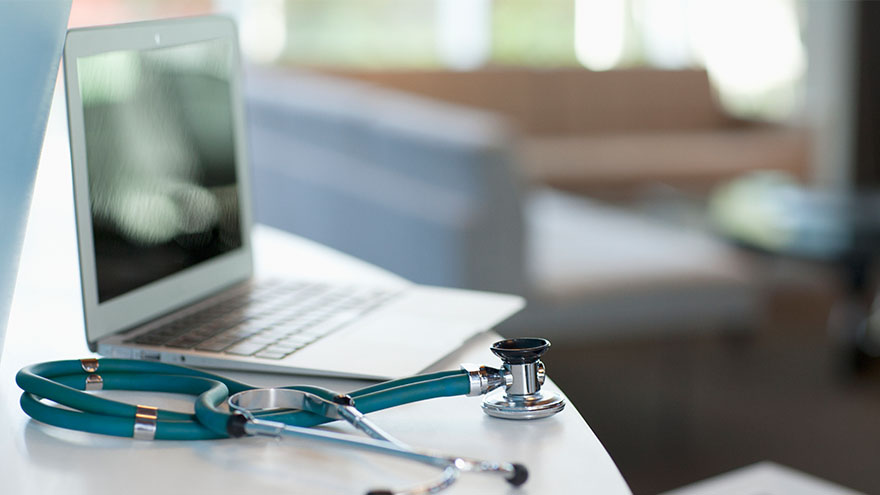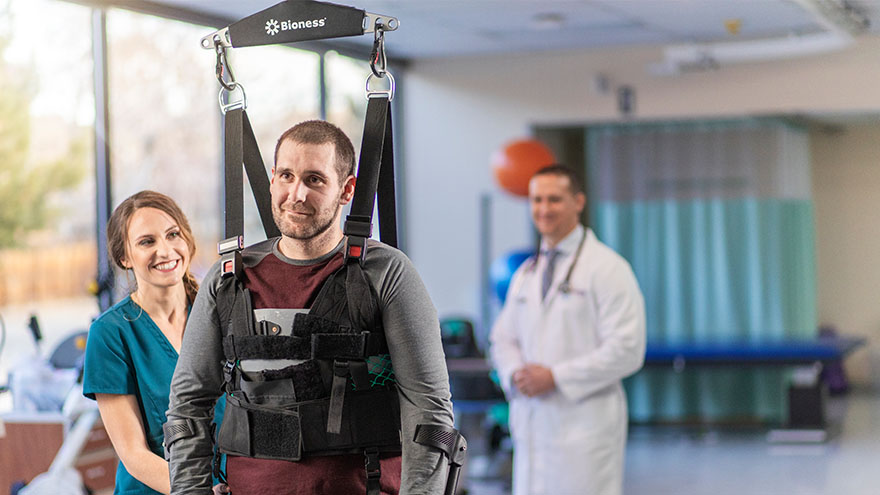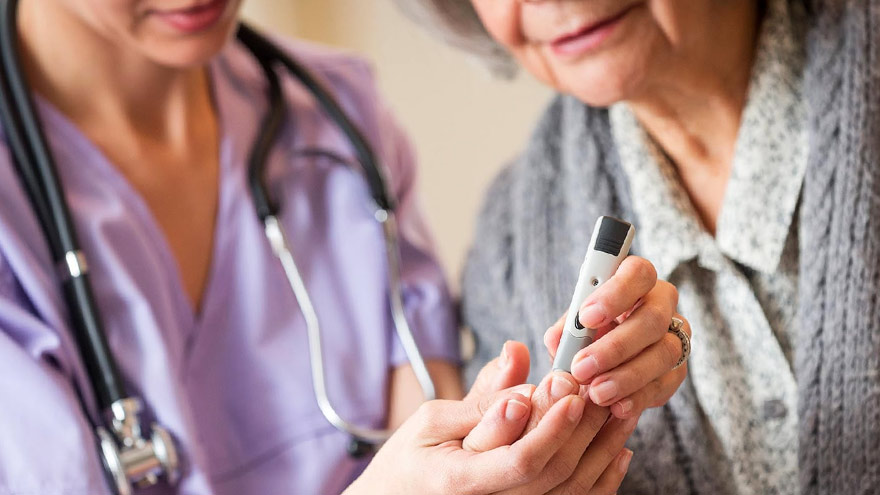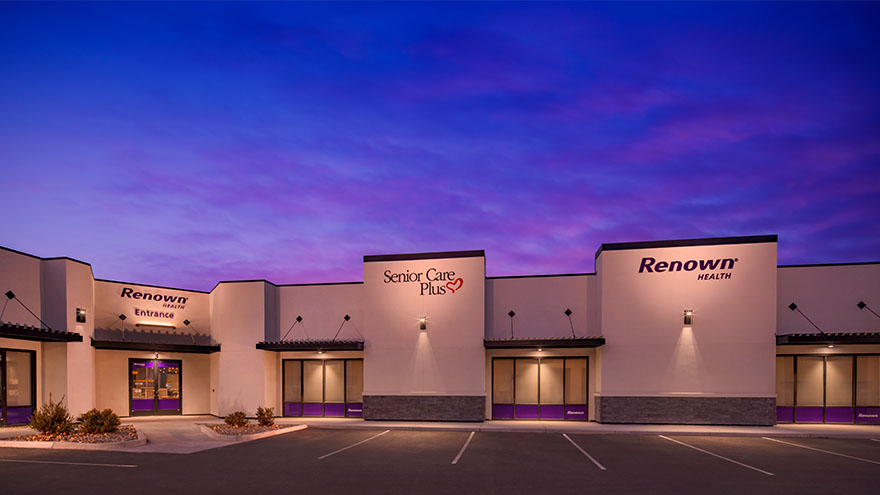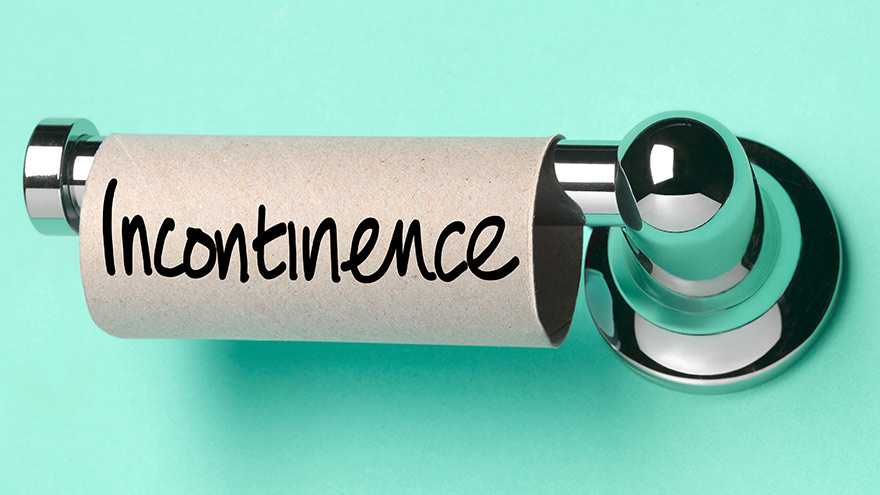Search
-
What is Care Coordination for Senior Care Plus Members?
Cost-saving isn’t the only reason to enroll in a Medicare Advantage Plan. One of the main reasons Medicare beneficiaries in Nevada join a Senior Care Plus Medicare Advantage Plan is for the care coordination services. The Senior Care Plus Care Coordination team helps members navigate what can be a complex healthcare system. Care coordination is a popular and extremely important service for members because keeping members healthy is the number one goal. One way they help reach this goal is to encourage members to participate in a no-cost, comprehensive health assessment. At this Quick Start Health Assessment, members meet with a geriatric specialist – a provider who specializes in the care of seniors – to discuss the 4 Ms: Mentation – Thinking, memory and mental health Medications – Understanding your medication Mobility – Staying physically active What Matters to You – Let your provider know what is important to you – examples could be family, health and independence The results of this detailed visit are then shared with the member’s primary care provider, so a customized care plan can be developed. This is a free service for Senior Care Plus members, along with an annual wellness visit and an annual physical exam. Care Team Approach – Laying the Foundation to Improve Health Health assessments and annual visits are offered so Renown Health providers can build relationships to improve care. This approach, also known as the Building Relationships to Improve Care or BRIC Model, is the care model used across Renown Health. “What’s special about this care model is that it really puts our patients at the center of their care,” says Savannah Gonsalves, a registered nurse with Senior Care Plus. “Members have their providers and nurses, Senior Care Plus personal assistants, case managers, and within the BRIC Model, they’re all talking to one another and putting the focus on the patient to meet needs.” Personal Assistants – A Unique Connection to Each Member A team of personal assistants is available to help members coordinate care by: Scheduling a member’s appointments Answering a member’s benefits questions Helping navigate care – these are experts in both health insurance and healthcare Answering questions about medications Working with providers to coordinate a member’s care The Senior Care Plus personal assistants are one of the most popular services that the Medicare Advantage plan offers. Each personal assistant has a direct phone line so members can call them to ask questions. “After my hip surgery my personal assistant, Megan checked in on me every day,” recalls Janelle, a Senior Care Plus member. “She made sure that I was doing alright and that I didn’t need anything. She just let me know that she was there for me.” To Learn More Senior Care Plus is the largest Medicare Advantage Plan in northern Nevada. They offer $0 plans with low co-pays with access to Renown Health and Teladoc Virtual Visits that cover you nationwide. To learn more about Medicare Advantage plans and to see if you qualify, visit SeniorCarePlus.com or call 775-982-3158 to speak to an enrollment specialist.
Read More About What is Care Coordination for Senior Care Plus Members?
-
MyChart Proxy Access
What is Proxy Access? Proxy access allows parents, legal guardians and caregivers to log into their personal MyChart account and connect to the health information of a patient they represent. As a proxy, you can view upcoming appointments, request appointments, view lab results, email a doctor on the patient’s behalf, view medications, request prescription refills and view health reminders. How Do I Establish Proxy Access? Login to your MyChart account with your username and password Go to the Profile menu at the top of the screen, then select Personalize From this screen you can see whose records you currently have access to Click Request Access to a minor’s chart Complete all of the fields When finished click Submit Request What if I Don’t Have a Renown MyChart Account? If you don’t have a Renown MyChart account, call 775-982-2781 and someone from the Renown Health MyChart team can help you set up proxy access. Keep in mind, the ability to request proxy access is only available on the MyChart website and not via the mobile app. However, the website can be accessed with your smartphone or tablet by using the web browser and going to mychart.renown.org.
-
Reliable Care From Home
Renown Health has always been on the frontlines of technological advancement, and that innovation remained unwavering during the COVID-19 pandemic. Our telehealth teams heeded the call to provide home monitoring for our patients, transforming how we provide care. The care providers at Renown successfully monitored lower acuity COVID-19 patients from the comfort of their own homes. Bernard Lee was diagnosed with COVID-19 and pneumonia, and was able to return home to continue his recovery with a home monitoring system. While at home, Bernard’s health took a turn for the worse while he was sleeping, but thanks to the continuous monitoring of Health at Home, his worsening vitals did not go unnoticed. “This monitoring system really saved my life,” Bernard said. “It was telling me that my sats were low, but I didn’t even feel the common COVID symptoms; I just felt tired.” Because of his low oxygen saturation (sats) and the continuous monitoring, he woke up to providers calling to check on him in the early morning. He was immediately transferred to the Renown Intensive Care Unit to be cared for and monitored by our expert care teams. Today Bernard is recovering, feeling great and continuously refers to the team and the home monitoring system as his guardian angels.
-
Tasty Turkey and Veggie Chili with Kale
Meet your new go-to healthy chili recipe for fall. Made to share or freeze the leftovers for an easy lunch or dinner. There’s nothing like homemade chili to warm you up on those cold winter nights. With just the right amount of comforting flavors and garden-fresh veggies, this crowd-pleasing favorite could prove to be your go-to healthy comfort meal.
-
The Road to Recovery Close to Home
Meet Connor Smith Life was hectic for Connor Smith. He had just finished at the top of his class at both the fire academy and paramedic school and was looking forward to starting work in northern Nevada. It was winter 2019, and he was ready to have some fun. The plan was to ride ATVs at Sand Mountain with his brother Cody, dad Lance and some friends, but a jump would change everything. Connor’s ATV took off but landed awkwardly, and he remembers immediately knowing he was paralyzed. Connor’s mom, Dana Shugar, was at home when she received the upsetting call from Cody, who told her he had an accident. Connor was flown to Renown Regional Medical Center, the area’s only Level II Trauma Center. After a seven-hour emergency surgery, Dana learned that Connor would live but only had a slight chance of walking again due to a spinal fracture. “The surgeon saved his life. It’s amazing how your life can change in a matter of seconds,” she said. Once his condition stabilized, Connor moved to the Renown Rehabilitation Hospital and began physical rehabilitation. “Thank God for the people at rehab,” Dana said. “Dr. Pence, the therapists, nurses and all the employees were a wonderful support system, explaining everything and answering all our questions. The kindness they showed got me through.” Connor agrees, calling the Renown rehab team nothing short of amazing.
-
5 Benefits of Medicare Advantage Plans
If you are approaching age 65, you may be starting to think about the government benefits you will soon qualify for. For example, your healthcare option to elect between Original Medicare or a Medicare Advantage plan. What’s the difference? Original Medicare comes in two parts: Part A and Part B. Part A covers a portion of hospitalization expenses, and Part B applies to doctor visits and medical expenses, such as lab tests and some preventative screenings. A Medicare Advantage plan, also known as Part C, is an “all-in-one” alternative to Original Medicare. These “bundled” plans include the benefits of Part A, Part B and Part D (prescription drugs). Some people choose a Medicare Advantage Plans over Original Medicare because these plans offer coverage like vision, hearing, dental and more. Saves You Money First and foremost, Medicare Advantage Plans save Medicare members money –and not just a little bit of money, but a lot of money. Original Medicare only pays 80% of the cost of medical care – the Medicare beneficiary is responsible for the other 20%. A Medicare Advantage Plan is different. The Medicare Beneficiary is only responsible for a small copay, typically less than 20% of a doctor visit or procedure. More importantly, Medicare Advantage Plans have a maximum out-of-pocket amount, meaning that once you reach the limit, the Plan pays 100% of all medical services. That alone can save thousands of dollars per year – particularly if there is a hospitalization involved. Dental, Vision and Hearing Coverage What sets Medicare Advantage plans apart is the additional benefits provided that Original Medicare doesn’t cover. These benefits include dental coverage, vision coverage, hearing exams and hearing aid coverage. None of these important health care benefits are included in Original Medicare. Also, most Medicare Advantage Plans include prescription drug coverage at no additional cost, while individuals with Original Medicare need to sign-up and pay extra for Part D prescription drug coverage. Medicare Advantage Plans offer more benefits than Original Medicare and they help members save on their health care costs. Focus on Accessibility, Wellness and Preventative Health Accessible healthcare coverage is key to staying on top of your health. To join a Medicare Advantage Plan you must have Part A and Part B coverage and live in the plan’s service area. It is important to remember that Original Medicare is only valid in the United States. Fortunately, many Medicare Advantage Plans offer worldwide emergency coverage. Another important healthcare consideration to keep in mind is Medicare Advantage Plans focus on your overall well-being. They offer preventative and wellness-related benefits at no cost to you. This includes important benefits like free over-the-counter medicines and free gym memberships. You won’t find those types of benefits with Original Medicare. Medicare Supplement Plans (Medigap) Some people confuse a Medicare Supplement Plan, also known as a Medigap Plan, with Medicare Advantage Plans. They are different and the biggest difference is Medicare Supplement plans come with ever-increasing premiums because they are based on your age. This means the cost of these plans increase every year. Plus, they don’t offer any supplemental benefit coverage like vision, dental or hearing. That’s not the case with a Medicare Advantage Plan. In many cases, there is no monthly premium and you receive all manner of supplemental benefits. These benefit-rich, zero-dollar premium Medicare Advantage plans are enticing people to say goodbye to pricy Medicare supplement plans and hello to Medicare Advantage Plans. Don’t worry, if you join a Medicare Advantage Plan for the first time and you aren’t happy with the plan, you’ll have special rights under federal law to buy a Medigap policy and a Medicare drug plan if you return to Original Medicare within 12 months of joining the Medicare Advantage Plan. The Flexibility to Change Your Mind A common misconception about Medicare Advantage Plans is that when you join, you are still on Medicare and are not giving up your Medicare coverage. Medicare Advantage Plans are considered “Medicare Part C.” This means they combine your Medicare Part A (hospital coverage), Part B (doctor’s coverage) and Part D (prescription drug coverage) into one convenient package that costs less and provides more. You can only join, switch or drop a Medicare Advantage Plan during the enrollment periods: Initial Enrollment Period: When you first become eligible for Medicare, you can sign up during your Initial Enrollment Period. For many, this is the seven-month period that begins three months before the month you turn 65, includes the month you turn 65, and ends three months after the month you turn 65. General Enrollment Period: If you have Part A coverage and you get Part B for the first time during this period (between January 1 - March 31 each year), you can also join a Medicare Advantage Plan. Your coverage may not start until July 1. Annual Election Period: Between October 15 and December 7, anyone with Medicare can join, switch or drop a Medicare Advantage Plan. Your coverage will begin on January 1 (as long as the plan receives your request by December 7). Medicare Advantage Plans have been around for more than 25 years and continue to grow in popularity. In some parts of the country, more than half of all Medicare beneficiaries are enrolled in a Medicare Advantage Plan. Only 40% are enrolled here in Nevada, but that number is growing every year.
-
5 Ways to Prevent Diabetes
November is National Diabetes Month, and with cases of the disease at an all-time high in the U.S., individuals must do everything they can to stay healthy. Learn more about diabetes prevention and also how to stop prediabetes in its tracks with these five helpful tips. Diabetes is a disease that is increasingly making its way into the public consciousness, and not in a good way. In fact, according to USA Today, diabetes has a greater health impact on Americans than heart disease, substance use disorder or COPD, with 30.3 million Americans diagnosed with the illness — and many more who are at risk for developing it. And those with prediabetes are at risk for developing type 2 diabetes in 10 years or less, according to the Mayo Clinic. The American Medical Association notes that 4 million U.S. adults have prediabetes. Check out the American Diabetes Association’s prediabetes risk test. The good news: There are ways to manage — and even reverse — prediabetes. Renown’s Certified Diabetes Educator Stephen Compston, RD, LD, CDE, shares five steps for managing blood sugar and also avoiding an eventual diagnosis. How to Prevent Diabetes Eat healthy foods. Plan meals that limit (not eliminate) foods that contain carbohydrates, which raise your blood sugar. Carbohydrates include starches, fruits, milk, yogurt, starchy vegetables (corn, peas, potatoes) and sweets. “Substitute more non-starchy vegetables into your meals to stay satisfied for fewer carbohydrates and calories,” Compston says. Exercise. Blood sugar is the body’s basic energy source. When you exercise, you are lowering your blood sugar. “People with prediabetes usually want to stay off of medication, so they must add something to their normal regimen that lowers blood sugar,” Compston says. “In this case, exercise is medicine.” Lose weight. A small decrease in your weight can drastically decrease your risk of developing diabetes in the future. The Diabetes Prevention Program study showed that a 7 percent decrease in body weight (14 pounds for a 200 pound person) can reduce a person’s risk of developing the disease by 58 percent. Get more rest. Studies link sleep issues to an increased risk of insulin resistance. It can also make it harder to lose weight. Thus, people that don’t get adequate sleep are at an increased risk for developing type 2 diabetes. See your doctor regularly. Schedule an appointment with your primary care provider at least once a year so you can track your health together. “A regular check-up and lab work can help identify what your blood sugars are doing so you and your doctor can develop a good plan for delaying the onset of diabetes,” Compston says.
-
A Facility Designed with Seniors in Mind
Did you know that members of Senior Care Plus, the largest Medicare Advantage Plan in northern Nevada, have access to an exclusive, senior-focused Renown Health primary care office right here in Reno? The facility – and the Medicare plan itself – are both designed with seniors in mind; this includes specialty staff, longer appointment times, on-site services, supportive furniture and more. 4 Benefits of an Exclusive Senior Care Plus Facility Centrally Located with Senior-Focused Staff The Senior Care Plus facility, located on Del Monte Lane, is only open to members of Senior Care Plus. This exclusive access means that the bilingual staff – including doctors, medical assistants, nurses and personal assistants – works daily with aging health needs. On-Site Services and Enrollment Specialists The Senior Care Plus providers understand that seniors often require complex care management and geriatric-focused services. That is why this location offers on-site lab draws, saving travel time and stress. Another essential service this location offers is longer appointment times, ensuring members don’t feel rushed when discussing their health needs with providers. Another perk of the Del Monte location – on-site enrollment specialists. Members, and potential members, can stop by this location on weekdays between 9 a.m. and 4 p.m. to have their SCP-related questions answered. Furniture Designed with Seniors in Mind Senior Care Plus makes a doctor visit as stress-free as possible. The office has furniture that makes each visit more comfortable for members. All of the office chairs have armrests, so seniors can easily get in and out of them. Also helpful are the exam room chairs with remote controls for reclining the chair and lifting the patient’s legs. This makes exams, such as a diabetic foot exam, less of a strain. Community Rooms Social connections are an important part of health. That is why the Del Monte Lane office has community rooms used for informative seminars and as a gathering place for members to mingle. The seminars focus on many interesting topics for older adults, such as diabetes, COPD, asthma, weight loss, nutrition, yoga and chair exercises.
-
Easy Gluten-Free Pumpkin Spice Bread
Pumpkin spice is a wonderful reminder of all things fall and cozy. This tasty pumpkin bread recipe is a favorite of both adults and kids. It incorporates fragrant fall spices – cinnamon, nutmeg and clove into a moist and surprisingly healthy bread. We replace regular flour with ground gluten-free whole grain oats courtesy of a blender. You won’t even notice our healthy substitutions of nonfat Greek yogurt and unsweetened applesauce. You’ll not only love the taste of this pumpkin bread, but also the wonderful aroma as it bakes filling your house with a mouthwatering scent. This generous recipe makes two loaves, one to keep and another to share with a friend or neighbor.
-
What Foods to Eat and What to Avoid When Pregnant
Eating a well-balanced and nutritious diet when pregnant is one of the more essential things you can do for your baby and yourself. The basic principles of what to eat when pregnant are quite similar to how we should be eating all the time. This includes focusing on fruits, vegetables, whole grains, lean protein and healthy fats. Of course, there are a few areas that you should pay close attention to when you’re pregnant and a few foods you should avoid. We consulted Renown Health’s Caitlin Bus, RD, LD, CDE to learn more about pregnancy nutrition. Foods to Eat Regularly: Veggies Vegetables of all kinds -- and in all forms -- are beneficial for you and your baby during pregnancy. Veggies ensure your body is getting the fiber, vitamins and minerals it needs. However, fresh or frozen veggies are considered best, but if you choose to eat canned veggies, make sure you choose a low sodium product. The more greens, the better! If you have an aversion to vegetables, especially in the first trimester, try sneaking them into smoothies. Healthy Proteins Protein-rich foods support your baby's growth while giving your body the nutrients to build and repair tissues, including your muscles, hair, skin and nails. Although protein requirements vary from person to person, a pregnant woman needs additional protein for her baby's growth, especially in the second and third trimesters. Regularly eating high protein foods -- like fish, chicken, turkey, eggs, peanut butter, nuts and beans –– promotes your baby's healthy brain and heart development. Grains Food like brown rice, quinoa, whole-wheat pasta and oatmeal are great to eat while pregnant. They are rich in fiber, iron, B vitamins and folic acid, which are all beneficial to physical development. Grains also help alleviate constipation and hemorrhoids. Fruits Fruit can help satisfy any sugar cravings you have when pregnant while also supplying your baby with nutrients – it's a win-win. Some people advise against fruit consumption while pregnant, but this is a myth. Like with all foods, moderation is key. Fruit can be high in sugar, so it is important to be aware of your intake. Also, make sure you are mindful of your preparation – thoroughly rinse produce under running water for 30 seconds to help avoid foodborne illness. Pasteurized Dairy Dairy products like milk, cheese and yogurt can be great sources of protein and calcium needed for the healthy development of a baby's bones, teeth and muscles. These foods also help with ensuring healthy heart function and nerve transmission. When buying these products, make sure to choose pasteurized products to avoid exposing your body to germs and bacteria. The American College of Obstetrics and Gynecology recommends 1,000mg of calcium per day for pregnant and lactating women. This equates to 4 servings of dairy or calcium-rich foods such as leafy greens, broccoli, tofu, almonds or dried figs. DHA Omega-3 Fats Omega-3s like DHA help support the health of a baby's brain and parts of their eyes. Women who are pregnant or breastfeeding should eat at least 8 ounces and up to 12 ounces of seafood each week. Ideally, food sources that offer DHA omega-3 and that are lower in mercury should be emphasized in your diet, including fish like salmon, sardines and anchovies. If you do not eat fish or omega-3 fortified foods, a DHA omega-3 supplement is recommended. Choline Did you know that 92% of pregnant women fail to meet the daily choline recommendation? Choline is crucial for an infant's brain and central nervous system development. One egg supplies 33% of the recommended daily intake. Although choline is often absent or low in prenatal vitamins, the best food sources include eggs, meats, fish, dairy, navy beans, Brussels sprouts, broccoli and spinach. Iron and Folic Acid Iron is the most common nutrient deficiency during pregnancy. Foods with high and moderate amounts of iron include red meat, chicken, fish, fortified cereals, spinach and beans. Folic acid is used to make the extra blood your body needs during pregnancy. Consuming adequate folic acid early in pregnancy reduces the risk of birth defects that affect the spinal cord. It is recommended to consume 400 micrograms (mcg) per day for pregnant women. This amount is included in your prenatal vitamins. Water Staying hydrated is one of the best things you can do for yourself and your baby when pregnant. In addition to just being good for you, hydration alleviates morning sickness and nausea, while dehydration can lead to contractions and even pre-term labor. Aim for 10 cups of fluids per day, on top of the water naturally occurring in foods. Foods to Avoid: Raw Fish and Fish with High Mercury Content Sorry sushi fans, according to the Center for Disease Control and Prevention, pregnant women are 10 times more likely to get infected by Listeria, a bacteria found in raw or undercooked fish. Also, avoid fish often found to be high in mercury, including swordfish, king mackerel, tuna and marlin. Processed or Raw Meat Similar to eating raw fish, eating undercooked or raw meat increases your risk of infection while pregnant. Hot dogs and lunch meats should also be avoided, unless they have been reheated to be steaming hot (for example, in a microwave). Alcohol Drinking alcohol when pregnant can impact your baby’s brain development and increases your risk of premature birth, low birth weight or miscarriage. Just don’t do it! Minimize Caffeine High caffeine intake during pregnancy can restrict your baby’s growth; therefore, it is recommended that pregnant people limit their caffeine intake to less than 200 mg per day – that’s roughly two cups (16 fl oz) of coffee per day. Runny Eggs Eating raw or runny eggs when pregnant increases your risk of Salmonella, which can cause fever, nausea, vomiting, stomach cramps and diarrhea. Always make sure your eggs are cooked through or use pasteurized eggs.
Read More About What Foods to Eat and What to Avoid When Pregnant
-
Why Your First Mammogram at 40 is a Vital Health Priority
A mammogram may not be on the top of your to-do list when you turn 40, but it needs to be. The American College of Obstetrics and Gynecology recommends a first mammogram at age 40, however you may need one earlier, so talk with your provider about your breast cancer risk. The purpose of a first time or baseline breast screening, is to get an accurate image of your breasts for future comparisons. Amber Snow, Supervisor of Renown Health Imaging, tells us why it’s important to get a baseline mammogram and what to expect during your visit. Mammogram Screenings Save Lives Simply put, a mammogram is a low-dose x-ray image of your breast from two views: top to bottom and side to side. A yearly screening reduces your risk of dying from breast cancer. Mammograms can detect signs of breast cancer even before you can see or feel it. That’s why it’s important to get a first- time mammogram. About 85% of breast cancers happen to those with no family history of it and in the U.S., one in eight women will develop breast cancer. Unfortunately, the two main risk factors for breast cancer: being female and aging. “Your baseline screening is important when you’re young, so that we know when changes occur,” explains Snow. “We compare your current mammogram to all your previous ones to know if anything changes year to year.” If you are under 40, talk to your provider about getting a formal risk assessment to see if a screening is right for you. If you have a family history of breast cancer a mammogram before age 40 or additional testing may be recommended for you. 3D Mammogram Technology Renown Health uses the latest 3D mammogram technology allowing our radiologists to see early changes in your breast tissue. This also reduces the number of false readings compared to traditional mammograms. While breast screening technology has improved, it is not uncommon to get called back after your first mammogram. According to the American Cancer Society, fewer than 10% of women called back for further testing have been found to have cancer. Reasons for being called back for further imaging include: Dense breast tissue, which can make it hard to see tumors A cyst, mass or unusual tissue is seen A possible area of concern needing another, closer look Preparing for Your Mammogram For an accurate image of your breasts do not wear deodorant, powders or lotions, as they can make it difficult to read your breast images. This is what will happen during your breast screening: A gown will be given to you and you will go to a private area to undress from the waist up, putting on the gown. You will then be escorted to the imaging room and a care team member will place one of your breasts between two plates. The plates will flatten to allow the most breast tissue to be seen and you will feel a firm pressure. You will be asked to hold your breath while the image is taken. An adjustment will be made to the plates to get a side view of the breast. The plate adjustments and images will be done on your other breast. Typically, a mammogram appointment is quick – only lasting about 15 minutes. Be Your Breast Friend While breast screenings are important, it’s also key that you know how your breasts normally look and feel. A monthly self-exam to check for lumps is essential, as breast cancers are often found during a routine self-exam. Remember your hormone levels change monthly, with your breast feeling tender and swollen right before your period. It’s best to perform a breast exam the week after your period after the swelling is gone. To avoid breast tenderness, this is also the best time for a mammogram.
Read More About Why Your First Mammogram at 40 is a Vital Health Priority
-
Don’t Put Your Bladder Health on Hold
Millions suffer from urinary incontinence (urine leakage). Often people feel as if their bladders control their lives. But this doesn't have to be your story. Bladder control issues are treatable and you can take steps to help control your bladder. What is urinary incontinence? Men and women of all ages can have difficulty controlling their bladders. Urinary incontinence occurs when the muscles in the bladder that control the flow of urine contract or relax involuntarily. Is there more than one type of urinary incontinence? Yes, there are three main types: Stress incontinence is when the bladder leaks small amounts of urine as a result of physical stress or pressure on the muscles supporting the bladder caused by coughing, sneezing, laughing, lifting or any sudden physical exercise such as running or jumping. Urge incontinence is the inability to control a strong urge to go without advance warning, limiting the time needed to get to the bathroom. Overflow incontinence occurs when the bladder does not empty properly. As a result, over time, large quantities of urine are stored, causing the bladder to overflow (this is more common in men and is often the result of an enlarged prostate blocking the bladder opening). Are there any tests that can determine the cause and type of incontinence? Your doctor may have you track your fluid intake and output in a Bladder Diary. A urinalysis can be checked for infection, traces of blood, or other abnormalities. Blood tests can look for chemicals or substances that may relate to contributing causes. Other testing may be an ultrasound, cystogram or post voiding residual measurement. How is urinary incontinence treated? Exercises to strengthen the pelvic floor muscles or restrain the bladder to hold on for longer. Medication can relieve and control the troublesome symptoms. If there is an infection an antibiotic is used. Surgery can repair weakened muscles or remove blockage. Special products such as pants, pads, collection devices, and chair and bed protection may be needed if the problem cannot be controlled. How do you strengthen your pelvic floor muscles? To make your pelvic floor muscles stronger, alternate between squeezing and relaxing them. Following the steps below may help: Squeeze your muscles for one second and hold. Relax your muscles for two seconds. Each time you squeeze and relax, it counts as one set. Complete five sets. When you can do the exercises easily, increase to doing them 10 times per day. When that gets easy, try to squeeze and hold the muscles for three seconds and then relax the muscles for three seconds. As your pelvic muscles get stronger, you can progress to longer squeezes for about 10 seconds. Be sure to relax between squeezes so that your muscles can rest before squeezing again. You should do these exercises in three different positions. Do 10 sets lying down, 10 sitting and 10 standing. It is important that you develop the habit of doing the exercises every day. You may want to exercise just after you get up in the morning and right before you go to bed at night. What can I do to help control incontinence? Watch your weight, practice pelvic floor muscle exercises, eat plenty of fresh fruits, vegetables and fiber to prevent constipation. Most importantly, talk to your doctor regarding incontinence issues, don’t be embarrassed!

